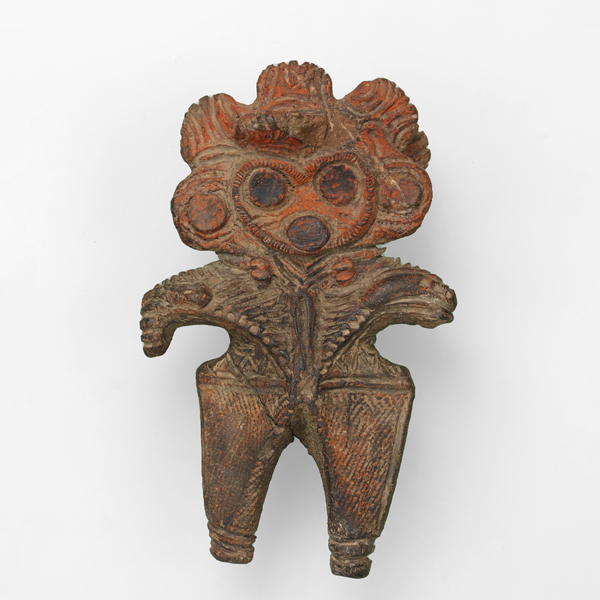縄文時代の祈りの道具・土偶
-

重要文化財 みみずく土偶 埼玉県さいたま市 真福寺貝塚出土 縄文時代(後期)・前2000~前1000年
平成館 考古展示室
2024年3月5日(火) ~ 2024年9月1日(日)縄文時代の祈りの道具の代表として土偶があります。土偶の多くは妊娠した女性を表わした例が多く、子孫繁栄や豊饒を祈るために作られたと考えられています。また土偶とともに用いられた祈りの道具として土面や土版に加え、動物や植物などをかたどった土製品があります。このような土製品は縄文時代の人びとの精神世界を解明する手がかりとして重要なものです。
| 指定 | 名称 | 員数 | 作者・出土・伝来 | 時代・年代世紀 | 所蔵者・寄贈者・列品番号 | 備考 | |
| おすすめ | 重文 | 遮光器土偶 | 1個 | 青森県つがる市木造亀ヶ岡出土 | 縄文時代(晩期)・前1000~前400年 | J-38392 | |
| 土偶 | 1個 | 茨城県利根町 花輪台貝塚出土 | 縄文時代(早期)・前7000~前4000年 | 野口かね氏寄贈 J-37525 | |||
| 土偶 | 1個 | 東京都八王子市楢原町出土 | 縄文時代(中期)・前3000~前2000年 | 塩野半十郎氏寄贈 J-37677 | |||
| 十字形土偶 | 1個 | 青森県八戸市南郷島守荒谷出土 | 縄文時代(中期)・前3000~前2000年 | 松舘富治氏寄贈 J-37416 | |||
| おすすめ | 重文 | みみずく土偶 | 1個 | 埼玉県さいたま市 真福寺貝塚出土 | 縄文時代(後期)・前2000~前1000年 | J-39223 | |
| みみずく土偶 | 1個 | 茨城県利根町 立木貝塚出土 | 縄文時代(後期)・前2000~前1000年 | 個人蔵 | |||
| 筒形土偶 | 1個 | 神奈川県横浜市 稲荷山貝塚出土 | 縄文時代(後期)・前2000~前1000年 | 個人蔵 | |||
| 土偶 | 1個 | 福島県会津若松市門田町御山出土 | 縄文時代(晩期)・前1000~前400年 | 個人蔵 | |||
| 遮光器土偶 | 1個 | 茨城県稲敷市 福田貝塚出土 | 縄文時代(晩期)・前1000~前400年 | 個人蔵 | |||
| おすすめ | 重美 | 熊形土製品 | 1個 | 青森県弘前市十腰内出土 | 縄文時代(後期)・前2000~前1000年 | J-37268 | |
| 重文 | 巻貝形土製品 | 1個 | 新潟県村上市 上山遺跡出土 | 縄文時代(後期)・前2000~前1000年 | J-38390 | ||
| 動物形土製品 | 1個 | 岩手県軽米町出土 | 縄文時代(晩期)・前1000~前400年 | 松舘富治氏寄贈 J-38318 | |||
| 土面 | 1面 | 長野県松本市波田上波田出土 | 縄文時代(後期)・前2000~前1000年 | 徳川頼貞氏寄贈 J-17949 | |||
| おすすめ | 土面 | 1面 | 埼玉県羽生市発戸出土 | 縄文時代(晩期)・前1000~前400年 | J-38330 | ||
| 重文 | 土版 | 1個 | 茨城県稲敷市 福田貝塚出土 | 縄文時代(晩期)・前1000~前400年 | 井上恒一氏・富美子氏寄贈 J-38401 | ||
| 土版 | 1個 | 出土地不詳 | 縄文時代(晩期)・前1000~前400年 | J-36878 | |||
| おすすめ | 岩偶 | 1個 | 青森県南部町小向出土 | 縄文時代(晩期)・前1000~前400年 | J-37266 | ||
| 岩版 | 1個 | 青森県つがる市森田町床舞出土 | 縄文時代(晩期)・前1000~前400年 | J-36837 |
